By Joan Brosnan
One of the most frequently asked questions; “Is there Poison Oak in the canyon?” can be answered with an emphatic, “Yes!” Poison oak thrives in the riparian (shady, moist habitats) in our local canyons and mountains.
Poison Oak, the most widely distributed shrub in California, can grow to 20 feet in height as well as aggressively run rampant along the ground twining through other trees and plants.
“Leaves of three, leave me be; the ancient wise proverb, should be heeded. Each leaf is divided into three leaflets. The middle leaflet extends on a visible stem away from the two leaves on either side. Children like to describe poison oak as “two leaves kissing and one running away.”
In spring, reddish leaves sprout, turn glossy green, then mature into a gorgeous kaleidoscope of green, red and orange in the fall. By winter, leaves have fallen to the ground, leaving seemingly harmless bare branches. What’s the harm in bare branches? The sap of the poison oak containsurushiol; an extremely irritating oil. This oil is present in the leaves, flower, fruit, bark, stems and roots. Burning poison oak as a method of eradication is not an option as the smoke may carry the oil particles. Severe blistering and itching can result from direct contact with all parts of poison oak as well as from secondary sources like dog fur that has brushed against foliage.
Toxicodendron diversilobum; the scientific name for Poison Oak, is appropriate as the translation means “poison tree, diversely lobed.”
Walking safely in Tecolote Canyon is easy. When in doubt-don’t. Stay on the trail. Keep your dog leashed and enjoy this amazing island of nature in a sea of housing and development.




